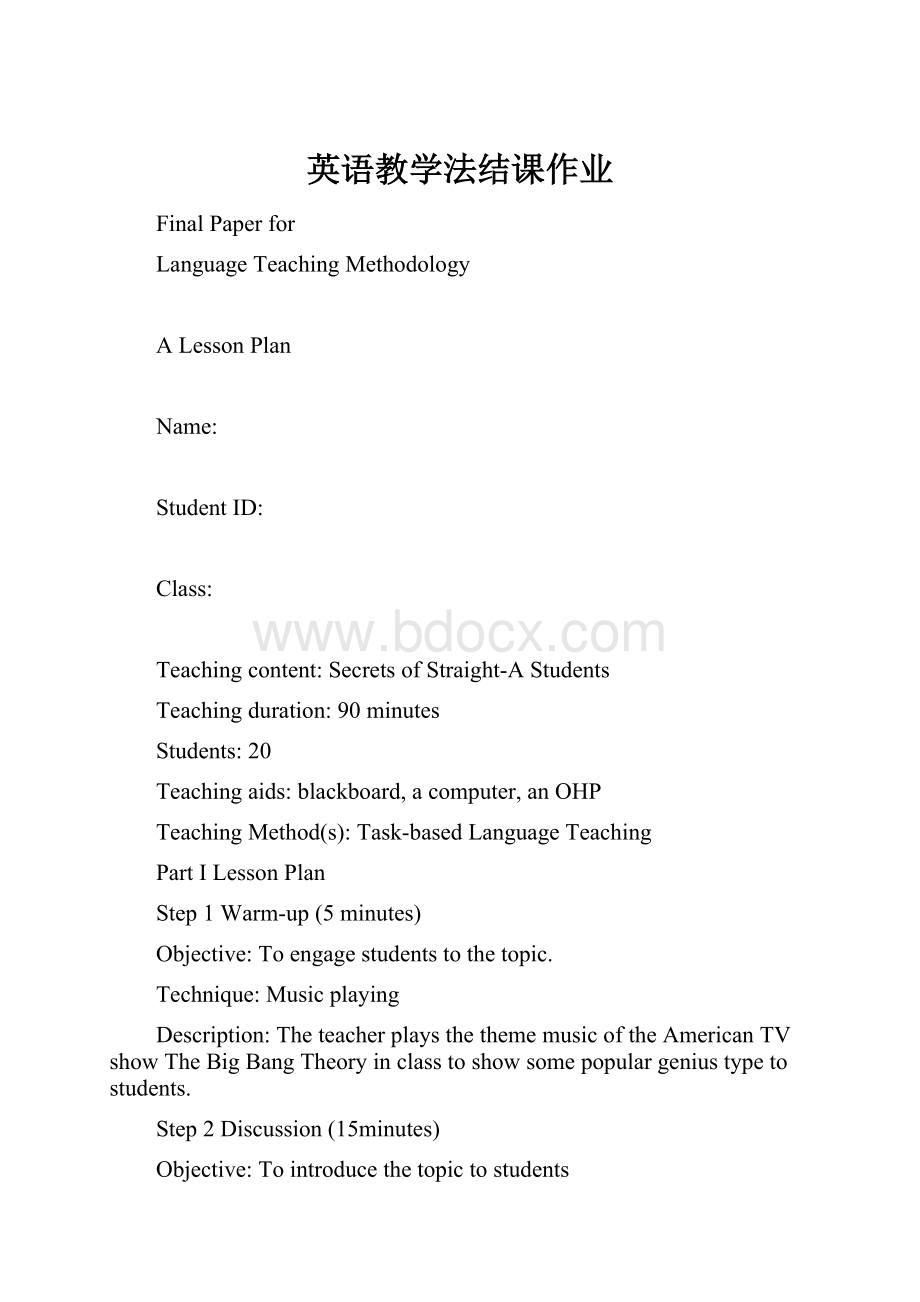英语教学法结课作业.docx
《英语教学法结课作业.docx》由会员分享,可在线阅读,更多相关《英语教学法结课作业.docx(11页珍藏版)》请在冰豆网上搜索。

英语教学法结课作业
FinalPaperfor
LanguageTeachingMethodology
ALessonPlan
Name:
StudentID:
Class:
Teachingcontent:
SecretsofStraight-AStudents
Teachingduration:
90minutes
Students:
20
Teachingaids:
blackboard,acomputer,anOHP
TeachingMethod(s):
Task-basedLanguageTeaching
PartILessonPlan
Step1Warm-up(5minutes)
Objective:
Toengagestudentstothetopic.
Technique:
Musicplaying
Description:
TheteacherplaysthethememusicoftheAmericanTVshowTheBigBangTheoryinclasstoshowsomepopulargeniustypetostudents.
Step2Discussion(15minutes)
Objective:
Tointroducethetopictostudents
Technique:
Raisingquestion,discussion
Description:
Theteacherasksstudentstodogroupdiscussionaboutthecharacteristicsofthosetypesofgenius,andthegroupleaderswritedownthemontheblackboard.ThentheteachermakesasummaryandintroducestheconceptofStraight-Astudenttotheclasses.
Step3ReadingComprehension(15minutes)
Objective:
Tohelpstudentsunderstandthepassage.
Technique:
quiz
Description:
Theteacherhandsoutthereadingmaterialswithquestionsaboutthecontenttothestudents.Thestudentshavetofinishthereadingandquizzeslessthan10minutes.Thentheteachergivestherightanswerswithexplanationtohelpstudentsunderstandthepassagewell.
Step4VocabularyLearning(15minutes)
Objective:
Tohelpstudentslearnsomewordsorphrasesandusefulexpressionsfromthearticle.
Technique:
game
Description:
Theteachergroupsthestudentstolookupnewwordsorusefulwordsinthedictionary.Eachgroupleaderwillputdownwhattheylearnedontheblackboardtoseewhichgroupgetsthemostwords.Thentheteacherasksthegroupmemberstomakeupsentencesusingthewordtheyfound.Theteachersummarizesthemistakesanderrors,anddemonstratestheappropriatenessofthewords.Theteachercommentsoneachgroup’sperformanceanddecidesthewinner.
Step5Activation(15minutes)
Objective:
Tolearnthesecretsofstraight-Astudentsclearly
Technique:
playingthevedio
Description:
Theteacherletsstudentswatchareportaboutstraight-Astudentsaroundtheworld,thenthestudentsmakereviewonthereport.
Step6Writing(25minutes)
Objective:
Topracticewhatthestudentslearned
Technique:
writing
Description:
Theteacheraskseachstudenttowriteasmallcompositionaboutstraight-Astudentlike“Myviewonstraight-Astudent”or“Adayofastraight-Astudent”.Theteacherdrawsthewritingstocheck,markandmakecomments.
PartIIRationaleofthelessonplan
1.IntroductionofTask-basedlanguageteaching
TheTask-basedlanguageteachingistheteachingbasedonaseriesoftasks,which,accordingtoWillis,areactivitieswherethetargetlanguageisusedbythelearnerforacommunicativepurpose(goal)inordertoachieveanoutcome.Ataskshouldcontendapurpose,acontext,aprocessandaproduct.TheTBLTisastrongformofcommunicativelanguageteachingusingtasksasbasisforteaching,focusingonform,andfollowingpre-,while-,post-taskmodel.Willisdeemsthatlearnersarebesetwithmultiplelinguistictasksatanygiventime,whicharelisting,orderingandsorting,comparing,creativetask(project),sharingpersonalexperiences,problemsolving(23).ByTBLT,learners,inbeingpresentedwithaspecifictask,areabletoactivatethedifferentlinguisticskillsandknowledgetheyneedtosuccessfullyaccomplishtheTask,which,initself,isanactofcommunication.
2.Majorprinciplesandcommonlyusedtechniques
TheTBLTisthefurtherdevelopmentofCLT.Itfollowssomeprinciples.1)thelanguagelearningprocessinvolvespersonalparticipationandpractice;2)learningthelanguagebyusingit,theproceduralknowledgeoutweighsthedescriptivelanguage;3)languagelearningrequiresinteraction,tasksshouldbeinteractiveorcooperative;4)languageteachingshouldarouseinterestbytasks;5)languagelearningshouldbemeaningful,taskorientedlearningdoesnotmeandullexercises,butlearningtaskswithspecifictargets.
Sentencemaking,readingexercisewithquizzes,writingwithatopic,Discussion,debate,gameorcompetition,pseudo-communication,androleplayarecommonlyusedinTBLT.
3.Justificationofthedesign
SincetheTBLTfocusonarousingtheinterestamongstudents,thelessonbeginwithamusicofthepopularAmericanTVshowTheBigBangTheory,alsothetopicisreferredto.Tomakeeverystudentparticipated,adiscussionisnecessary.LearningbyusingistheimportantconceptinTBLT,thusthesentencemaking,writingtaskaredesignedtoletstudentspracticewhattheylearn.Games,quizzes,andwatchingvedioarechallengingandinterestingthatcanmakethestudentsbemoreresponsive.
Jane,Willis."AFrameworkforTask—basedLearning."(1996:
23).
附:
SecretsofStraight-AStudents优等生的成功秘诀
ByEdwinKiester,Jr.andSallyValenteKiesterfromReader'sDigest
Everyoneknowsaboutstraight-Astudents.Theygethighgrades,allright,butonlybybecomingdullgrinds,theirnosesalwaysstuckinabook.They'reclumsyatsportsandfailureswhenitcomestotheoppositesex.
人们都知道全优学生是什么样的。
的确,他们能考高分,但却变成愚钝的书呆子,总是把头埋在书本里。
他们在体育运动方面笨手笨脚,在和异性交往方面也很无能。
How,then,doweaccountforDomenicaRomanorPaulMelendres?
那么,我们又该如何解释多米尼卡·罗曼或者保罗·梅勒德莱斯的情况呢?
Romanisonthetennisteamatherschool.Shealsosingsinthechoralensemble,servesonthestudentcouncilandisamemberofthemathematicssociety.Fortwoyearsshehasmaintaineda4.0grade-pointaverage(GPA),meaningA’sineverysubject.
罗曼是学校网球队的队员、合唱团团员,她在学生会担任职务,还是数学学会的会员。
在连续两年里,她一直保持着各科成绩的平均积分点为4.0,即各科都得优。
Melendres,nowauniversityfreshman,wasstudent-bodypresidentathissecondaryschool.Heplayedsoccerandbasketball,exhibitedatthesciencefair,washonoredforacademicexcellence,characterandservice,didstudentcommentariesonalocaltelevisionstationandwasvaledictorian.
梅勒德莱斯现在是大学一年级的学生,他曾经是中学学生会的主席,是该校足球队、篮球队队员,在科学博览会上展出过作品,因学习成绩优秀、品德良好、服务社会而受到表彰,他在当地电视台担任过学生评论员,他还是致告别辞的毕业生代表。
Howdosuper-achieverslikeRomanandMelendresdoit?
Brainsaren’ttheonlyanswer.“Topgradesdon’talwaysgotothebrighteststudents,”declaresprofessorofeducationHerbertWalberg,whohasconductedmajorstudiesofsuper-achievingstudents.“Knowinghowtomakethemostofyourinnateabilitiescountsformore.Infinitelymore.”
像罗曼和梅勒德莱斯这样的优等生是怎样取得如此好的成绩的呢?
智力天赋不是唯一的答案。
一直在对这类优秀学生进行重点研究的教育学教授赫伯特·沃伯格说:
“最聪明的学生不见得总是得高分。
善于最充分地利用自己内在潜力其实是更为重要的,而且是极其重要的。
”
Infact,Walbergsays,studentswithhighI.Q.ssometimesdon’tdoaswellasclassmateswithlowerI.Q.s.Forthem,learningcomestooeasilyandtheyneverfindouthowtobuckledown.
沃伯格说,事实上,智商高的学生有时成绩不如那些智商较低的同学。
对他们来说,学习是件轻而易举的事,因而他们从未想过如何全力以赴地学习。
Hardworkisn’tthewholestory,either.“It’snothowlongyousittherewiththebooksopen,”saidoneofthemanyA-studentsweinterviewed.“It’swhatyoudowhileyou’resitting.”Indeed,someofthesestudentsactuallyputinfewerhoursofhomeworktimethantheirlower-scoringclassmates.
勤奋也不是全部的原因。
在我们采访的许多全优学生中,有一位学生这样说:
“不在于你面对书本坐多长时间,而在于你坐在那儿干什么。
”确实,有些全优学生花在家庭作业上的时间比成绩不如他们的同学要少。
Thekidsatthetopoftheclassgettherebymasteringafewbasictechniquesthatotherscanreadilylearn.Here,accordingtoeducationexpertsandstudentsthemselves,arethesecretsofstraight-Astudents.
其实,这些孩子就是掌握了人人都可以轻而易举学到的一些基本技巧而成为班上的尖子生。
下面就是根据教育专家和学生们自己,总结出来的一些优等生的成功秘诀。
1.Setpriorities.Topstudentsbrooknointrusionsonstudytime.Oncethebooksareopenorthecomputerisbootedup,phonecallsgounanswered,TVshowsunwatched,snacksignored.Studyisbusiness;businesscomesbeforerecreation.
1.确保正事优先。
尖子生不能容忍在学习过程中被打扰。
一旦打开书本或电脑启动,电话铃声将充耳不闻,电视节目将视而不见,点心也置之不理。
学习是正事,正事应先于娱乐。
2.Studyanywhere---oreverywhere.ClaudeOlney,aUniversitybusinessprofessorassignedtotutorfailingcollegeathletes,recallsacross-countryrunnerwhoworkedouteveryday.Olneypersuadedhimtousethetimetomemorizebiologyterms.Anotherstudentpostedavocabularylistbythemedicinecabinet.Helearnedanewwordeverydaywhilebrushinghisteeth.
2.学习不论场合。
克劳德·奥尔尼是一位工商管理教授,他曾被指派辅导学习掉队的学校体育运动员。
他回忆起一位每天都参加训练的越野跑运动员,奥尔尼劝他利用训练的时间记忆生物学术语。
另一位学生把词汇表贴在药品贮藏柜旁边,于是,每天刷牙时他就学到一个新单词。
Amongthestudentsweinterviewed,studytimeswerestrictlyamatterofpersonalpreference.Someworkedlateatnightwhenthehousewasquiet.Othersawokeearly.Stillothersstudiedassoonastheycamehomefromschoolwhentheworkwasfreshintheirminds.Allagreed,however,ontheneedforconsistency.“WhateverIwasdoing,Imaintainedasloteverydayforstudying,”saysuniversitystudentIanMcCray.
在我们采访的学生中,他们的学习时间严格地说是根据个人偏爱安排的。
有人喜欢在夜深人静时学习,有人愿意早起,也有人一放学回家趁课堂内容还没有淡忘就开始学习。
尽管安排不同,但都赞同学习要有连贯性。
大学生伊恩·麦克雷说,“不管在做什么,我每天都坚持用一段时间来学习。
”
3.Getorganized.Insecondaryschool,McCrayrantrack,playedrugbyandwasinthebandandorchestra.“Iwassobusy,Icouldn’twastetimelookingforapencilormissingpaper.IkepteverythingrightwhereIcouldputmyhandsonit,”hesays.
3.归放学习资料有条理。
在中学时,麦克雷参加田径运动、打橄榄球,还参加了管弦乐队。
他说:
“我太忙了,不能浪费时间去找一支铅笔或一张丢失的卷子。
所以,我把一切学习用品都放在随手可及的地方。
”
PaulMelendresmaintainstwofolders---onefortheday’sassignments,anotherforpaperscompletedandgraded.TraciTsuchiguchi,asuper-achieversecondaryschoolstudent,hasanothersystem.Sheimmediatelyfilestheday’spapersincolor-codedfoldersbysubjectsothey’llbeavailableforreviewatexamtime.
保罗·梅勒德莱斯有两个文件夹——一个用来放当天的作业,另一个用来放做完并批改了的试卷。
特蕾西·特鲁奇格奇是一名优秀中学生,她有另一种分类方法。
每次她都及时地把当天的考卷按科目分别存入按颜色编排的文件夹里,以便在考试复习时用起来方便。
Evenstudentswhodon'thaveaprivatestudyarearemainorganized.Abackpackordrawerkeepsessentialsuppliestogetherandcutsdownontime-wastingsearches.
甚至那些自己没有书房的学生也把所有东西归放得井井有条。
他们把必需的学习用品统一放在一个背包或抽屉里,这样就可以节省许多找东西的时间。
4.Learnhowtoread.“Th